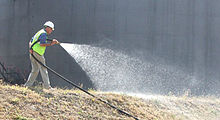Erosion control: Difference between revisions
Appearance
Content deleted Content added
No edit summary |
|||
| Line 1: | Line 1: | ||
[[Image:TerracesBuffers.JPG|thumb|right|Terraces, conservation tillage, and conservation buffers save soil and improve water quality on this Iowa farm. 1999. Photo by Lynn Betts, USDA Natural Resources Conservation Service.]] |
[[Image:TerracesBuffers.JPG|thumb|right|Terraces, conservation tillage, and conservation buffers save soil and improve water quality on this Iowa farm. 1999. Photo by Lynn Betts, USDA Natural Resources Conservation Service.]] |
||
pie in my ambluance is my hands in my pockets fish chuck norrisis" the practice of preventing or controlling wind or water [[erosion]] in [[agriculture]], [[land development]] and [[construction]]. This usually involves the creation of some sort of physical barrier, such as vegetation or rock, to absorb some of the energy of the wind or water that is causing the erosion. Effective erosion controls are important techniques in preventing [[water pollution]] and [[soil]] loss. On construction sites they are often implemented in conjunction with [[sediment control]]s such as [[sediment basin]]s and [[silt fence]]s. |
|||
Examples of some erosion control methods include: |
Examples of some erosion control methods include: |
||
Revision as of 14:27, 28 April 2009

pie in my ambluance is my hands in my pockets fish chuck norrisis" the practice of preventing or controlling wind or water erosion in agriculture, land development and construction. This usually involves the creation of some sort of physical barrier, such as vegetation or rock, to absorb some of the energy of the wind or water that is causing the erosion. Effective erosion controls are important techniques in preventing water pollution and soil loss. On construction sites they are often implemented in conjunction with sediment controls such as sediment basins and silt fences.
Examples of some erosion control methods include:
|
See also

- Baer's law
- Bridge scour
- Burned area emergency response
- Certified Professional in Erosion and Sediment Control CPESC
- Coastal management
- Dust Bowl
- Natural Resources Conservation Service (United States)
- Nonpoint source pollution
- Stormwater
- Universal Soil Loss Equation
- Vetiver
References
- U.S. Natural Resources Conservation Service (NRCS). Washington, DC. "National Conservation Practice Standards." National Handbook of Conservation Practices. Accessed 2009-03-28.
- ^ State of California Department of Transportation, Division of Environmental Analysis, Stormwater Program. Sacramento, CA."Cellular Confinement System Research." 2006.
- ^ Tennessee Department of Environment and Conservation. Nashville, TN."Tennessee Erosion and Sediment Control Handbook." 2002.
External links
- Erosion Control - a trade magazine for the erosion control industry
- International Erosion Control Association - Professional Association, Publications, Training
- WatchYourDirt.com - Erosion Control Educational Video Resource
- Soil Bioengineering and Biotechnical Slope Stabilization - Erosion Control subsection of a website on Riparian Habitat Restoration
- Vetiver Network International - Soil and water management method
